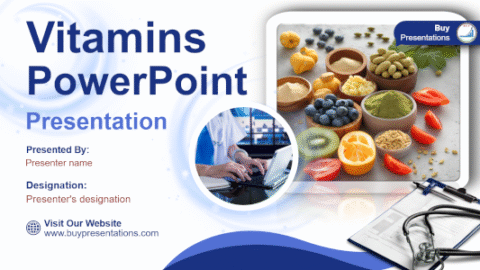Complete Vitamins PowerPoint Presentation Guide
Introduction to Vitamins PowerPoint Presentation:
A Vitamins PowerPoint Presentation is a powerful educational tool developed to simplify the complex world of micronutrients. Whether you’re teaching medical students, health-focused people, or students, a carefully designed presentation might graphically communicate the importance, types, sources, and functions of vitamins in the human body. It bridges the gap among prescribed theory and real-world application, creating learning both accessible and memorable.
Why Use a Vitamins PPT for Teaching and Learning:
Using a PowerPoint presentation to teach about vitamins offers several advantages:
- Visual Learning: Diagrams, charts, and infographics help learners grasp biochemical processes and nutrient functions.
- Structured Delivery: Slides allow for a logical flow—from definition to classification, sources, deficiencies, and therapeutic uses.
- Interactive Engagement: Embedded quizzes, animations, and case studies can boost retention and participation.
- Cross-Platform Adaptability: Easily shareable across Zoom, Google Slides, or LMS platforms for remote or in-person learning.
Design Tips for an Engaging Vitamins PowerPoint Presentation:
To make your presentation visually appealing and pedagogically effective:
- Use Color Coding: Assign distinct colors to fat-soluble (A, D, E, K) and water-soluble (B-complex, C) vitamins.
- Incorporate Icons and Images: Use food icons, deficiency symptoms, and molecular structures to reinforce concepts.
- Limit Text Per Slide: Stick to bullet points and short phrases to maintain attention.
- Choose Readable Fonts: Sans-serif fonts like Arial or Calibri ensure clarity, especially on smaller screens.
- Add Transitions Sparingly: Use subtle animations to guide focus without distracting.
Slide-by-Slide Breakdown of a Vitamins PPT:
Here’s a suggested structure for your presentation:
| Slide | Title | Content Highlights |
| 1 | Title Slide | Presentation name, presenter info |
| 2 | What Are Vitamins? | Definition, classification |
| 3 | Fat-Soluble Vitamins | A, D, E, K – sources, functions, deficiencies |
| 4 | Water-Soluble Vitamins | B-complex, C – roles, absorption, excess |
| 5 | Vitamin Deficiencies | Common symptoms, global health impact |
| 6 | Dietary Sources | Food charts, recommended daily intake |
| 7 | Supplementation | When and why supplements are needed |
| 8 | Quiz or Case Study | Interactive learning element |
| 9 | Summary | Key takeaways |
| 10 | References & Resources | Credible sources, further reading |
Optimizing Your Vitamins PPT for Clarity and Impact:
To ensure your presentation is both informative and impactful:
- Use High-Contrast Colors: Improve readability, especially in bright rooms or on projectors.
- Highlight Key Terms: Bold or color-code important concepts like “Vitamin D deficiency” or “RDA.”
- Include Real-Life Examples: Link vitamin functions to common health conditions (e.g., scurvy and Vitamin C).
- Add Speaker Notes: Provide context or elaboration for each slide to guide your delivery.
Target Audience Considerations for Your Vitamins Presentation:
Tailor your presentation based on who you’re teaching:
- Medical Students: Include biochemical pathways, clinical case studies, and pharmacological relevance.
- General Public: Focus on dietary sources, lifestyle tips, and practical health advice.
- School Children: Use cartoons, simplified language, and fun facts to maintain interest.
- Nutritionists/Dietitians: Emphasize dietary planning, supplementation protocols, and client education strategies.
Downloadable Templates for Vitamins PPT Presentation:
Save time and enhance professionalism with ready-made templates:
- Medical Education Templates: Clean, clinical designs with placeholders for molecular diagrams.
- Health & Wellness Themes: Bright, organic visuals ideal for public health talks.
- Interactive Layouts: Templates with embedded quizzes, drag-and-drop activities, or clickable menus.
- Free Resources: Sites like SlidesCarnival, Canva, Buy Presentations and Microsoft Office offer customizable vitamin-themed templates.
Final Tips to Make Your Vitamins PowerPoint Presentation Stand Out:
- Start with a Hook: Use a surprising fact or question like “Did you know 1 in 3 people are Vitamin D deficient?”
- End with a Call to Action: Encourage dietary changes, further reading, or health checkups.
- Practice Delivery: Rehearse to ensure smooth transitions and confident pacing.
- Gather Feedback: After presenting, ask for input to refine future versions.
